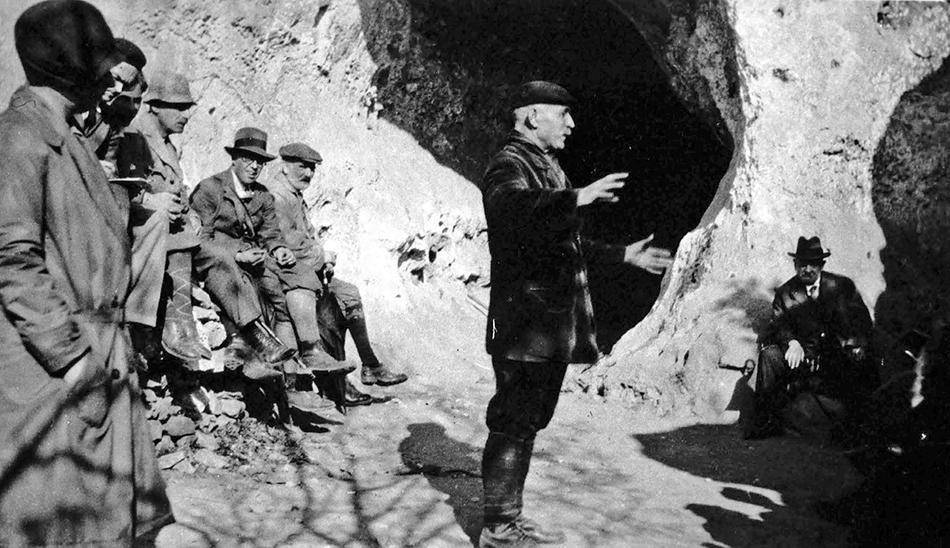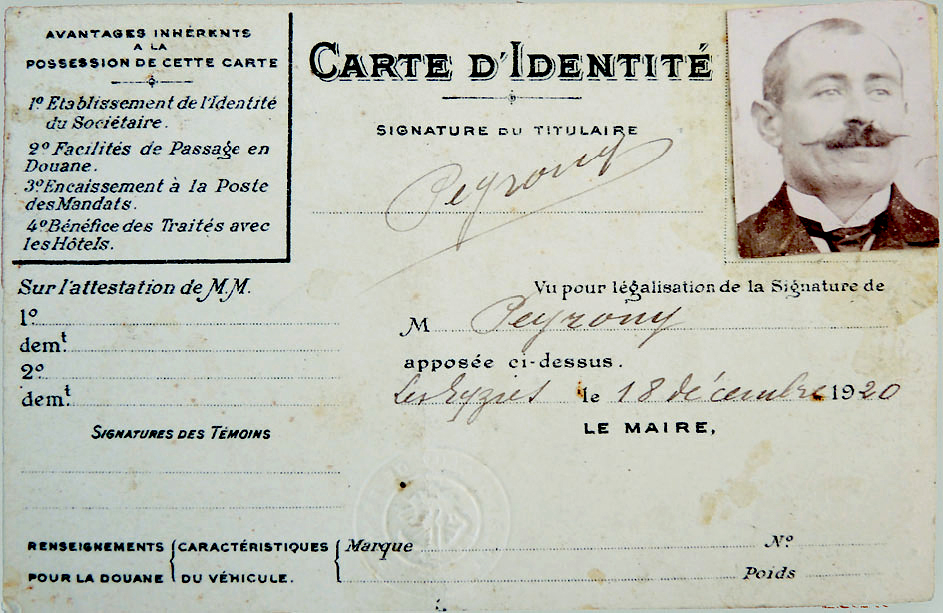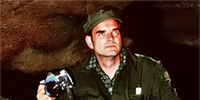Back to Don's Maps
Back to Sites Index Page
Font de Gaume - Cave Paintings from the Ice Ages
Font-de-Gaume is a cave near Les Eyzies. The cave contains prehistoric polychrome cave paintings and engravings. The paintings were discovered by Denis Peyrony, a local schoolmaster, on 12 September 1901. The cave had been known to the general public before this, but the significance of the paintings had not been recognised. Four days previously Peyrony had visited the cave at Les Combarelles, a short distance away, with the archaeologist Henri Breuil, where he saw its prehistoric engravings. The paintings in the cave at Font-de-Gaume were the first to be discovered in the Périgord province. Prehistoric people living in the Dordogne Valley first settled in the mouth of Font-de-Gaume around 25 000 BC. The cave mouth was inhabited at least sporadically for the next several thousand years. However, after the original prehistoric inhabitants left, the cave was forgotten until the nineteenth century when local people again began to visit the cave. The paintings date from around 16 000 BP, during the Magdalenian period. Many of the cave's paintings have been discovered in recent decades. The cave's most famous painting, a frieze of five bison was discovered accidentally in 1966 while scientists were cleaning the cave.Text above: Wikipedia
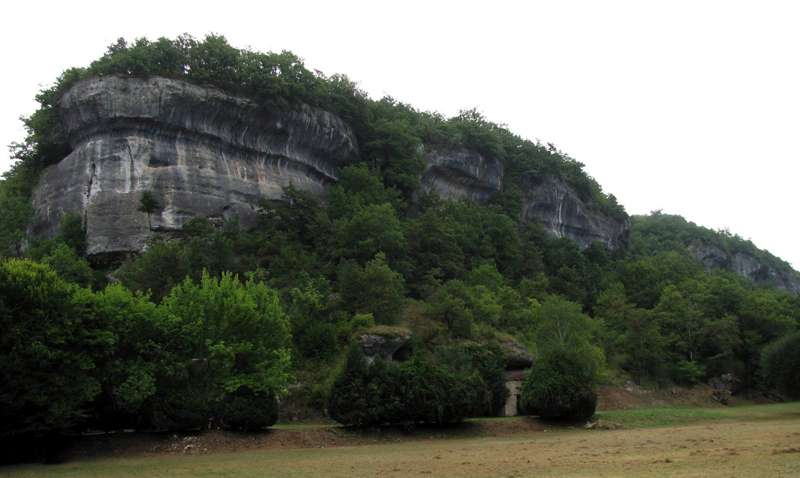
This photograph gives a good idea of where the cave fits in the local landscape. The cave entrance is on the right background of the photo, at the point where the third lot of trees climbs up the slope, dividing the cliff into four segments in this photo. The cave contains many paintings from the Ice Ages.
Photo: Don Hitchcock 2008
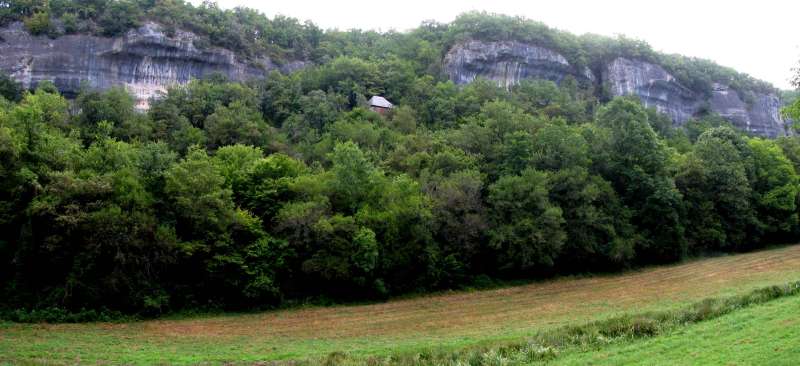
Further along the cliff line.
While most photos of Font de Gaume on archaeology websites show only the prominent headland jutting out over the parking area for the busy ticket office at Font de Gaume, which services all ticketing for the large number of archaeological sites in the area, the actual entrance for the cave is up hill behind the small building shown in the panorama above.
This view is obtained by going up the side road not far from the ticket office.
Photo: Don Hitchcock 2008
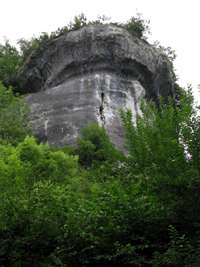
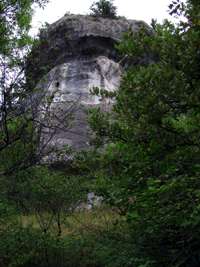
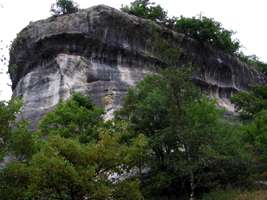
These are close ups of the prominent headland near the Font de Gaume cave, and above the ticket office there. From the ticket office there is an uphill walk of several hundred metres to the entrance to the cave, and these photos show successive views on the way up the path.
Ayla (from the book 'Shelters of Stone' by Jean Auel) says it looks like the face of the Mother.
Photo: Don Hitchcock 2008
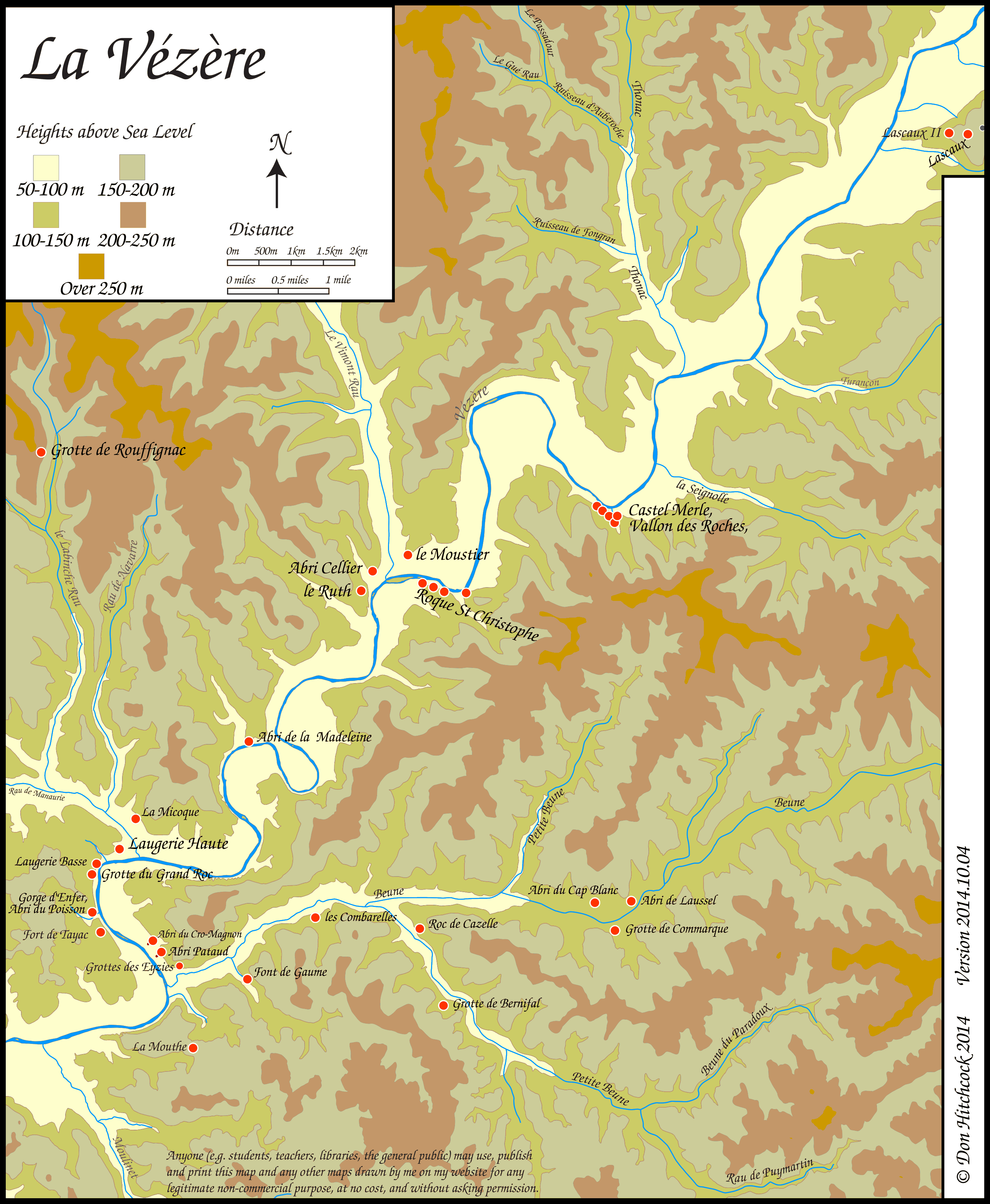
Map of sites in the Vézère Valley of France, including Font de Gaume.
If you click on the map you will see a larger map with the ability to click on the marked sites and get further information.
Photo: Don Hitchcock
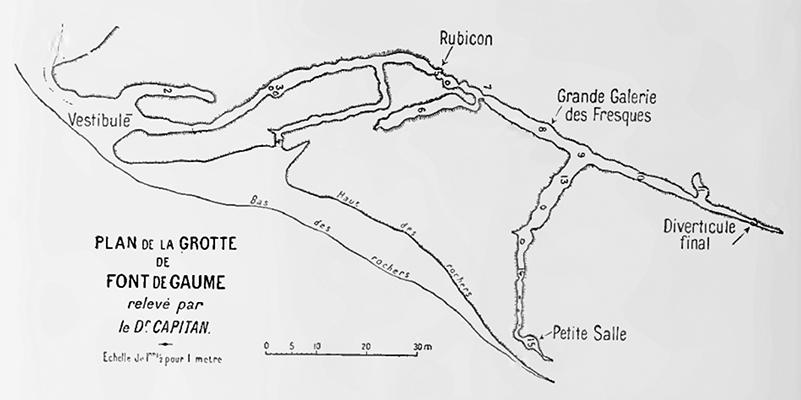
Map of the cavern of Font-de-Gaume, showing the 'Rubicon', the Grande Galerie des Fresques, in which the chief polychrome paintings are found, and the Diverticule final. After Capitan.
Photo and text: Osborn (1915)
Denis Peyrony at the entrance to Font de Gaume.
Note that Peyrony is wearing clothing suitable for cycling, as are some of his listeners.
Photo: Unknown photographer
Proximal source: journals.openedition.org/paleo/4058?lang=fr
Denis Peyrony's Identity card from the Touring Club de France, 1920. No doubt he used a bicycle for many of his trips to and from various gisements, as in the photo above.
Source: Bibliothèque municipale de Périgueux, de Sonneville-Bordes collection
Proximal source: journals.openedition.org/paleo/4058?lang=fr
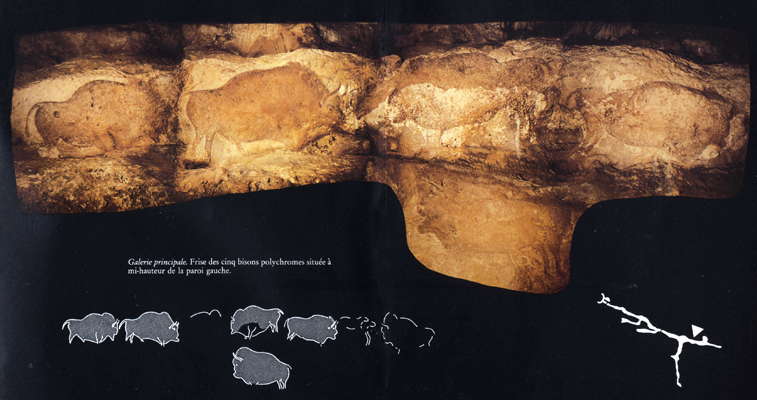
This magnificent frieze of five bisons was only discovered in 1966. It had been obscured and protected by a layer of grey calcite mixed with iron and clay deposits that had made the paintings almost invisible. They were thus protected from the fate of many of the first paintings to be discovered, which were in some cases obscured with graffiti.
Five bison, with finely engraved contours and with their bodies painted in black-brown and red, against a background of yellow limestone concretions above a ledge, for at least four of them, form a composition full of life. It includes males and females, and the males are shown with penises.
The floor of the cave was lowered by about a metre to make the splendid frieze of animals out of reach of visitors and thus protect them. The location of the frieze is shown on the photo above, between the crossroads and the Cabinet des Bisons, towards the far end of the cave.
Photo and text: Fanlac (1994)
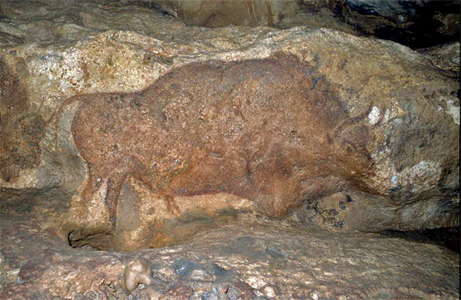
One of the frieze of five bison. The paintings were restored to their former glory in 1968 when the calcite, clay and iron deposits which had protected them from the elements and from the graffiti of early visitors were removed from the paintings.
Photo: http://www.culture.gouv.fr/culture/conservation/fr/grottes/Pageshtm/11714.htm
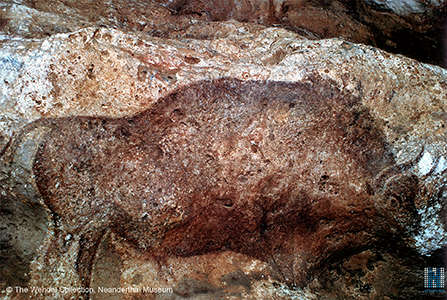
Bison.
Photo: Heinrich Wendel (© The Wendel Collection, Neanderthal Museum)
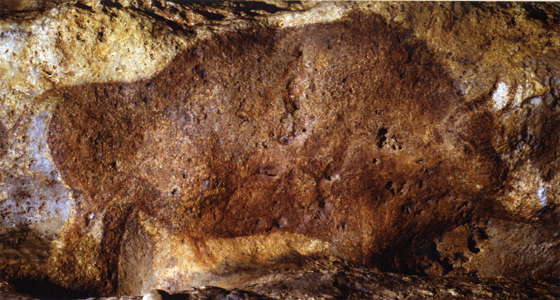
This is the bison second from the left in the panorama of bisons above.
It is one of the finest polychromatic bison, in the last gallery. The subtle variations of browns, the details of the animal's anatomy and fur texture, and of its expression, make this painting one of the most remarkable examples of cave art.
Photo and text: Desdemaines-Hugon (2010)
Photo © N. Aujoulat-CNP-MCC.
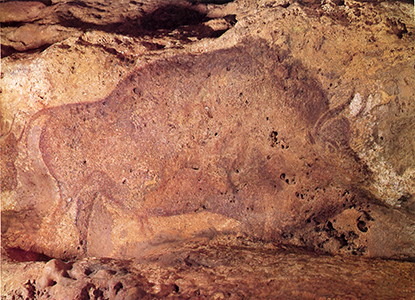
Another version of the bison.
Photo: P. Vidal LRMH
Source: Leroi-Gourhan (1984)
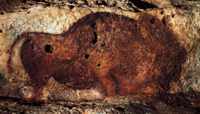 Les hauts lieux de la préhistoire dans la vallée de la Vézère sont essentiels à la connaissance de l'expression symbolique paléolithique (~35 000 / ~9 000 av. J-C.) avec notammement les grottes de Font-de-Gaume, des Combarelles et l'abri du Poisson (Les Eyzies-de-Tayac).
Les hauts lieux de la préhistoire dans la vallée de la Vézère sont essentiels à la connaissance de l'expression symbolique paléolithique (~35 000 / ~9 000 av. J-C.) avec notammement les grottes de Font-de-Gaume, des Combarelles et l'abri du Poisson (Les Eyzies-de-Tayac).
Galerie principale, seconde partie, paroi de gauche, Frise des cinq bisons, sujet de gauche.
Text and photo: Postcard from Monum, Éditions du patrimoine
This is a closeup of the left most bison in the frieze of bisons. My thanks to Anya for sending this postcard.
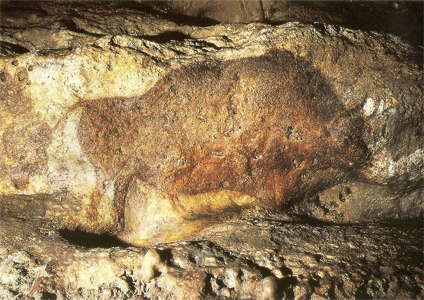
Another version of the bison above, showing the surroundings of this important figure.
Photo: http://smspostcard2.blogspot.com/2010/07/france-aquitane-dordogne-font-de-gaume.html
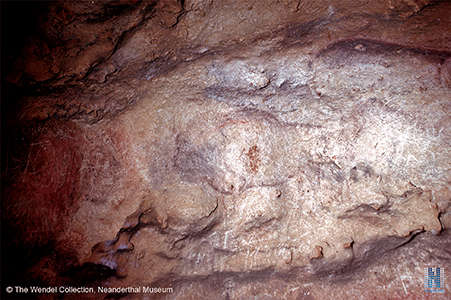
Bison, second from right, Galerie Principale.
Photo: Heinrich Wendel (© The Wendel Collection, Neanderthal Museum)

Cro-Magnon artists painting in the Font-de-Gaume.
Photo: Charles R. Knight, 1920
Permission: Public Domain
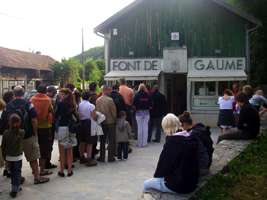
Ticket Office at Font de Gaume, which controls access to all the gisements / archaeological sites in the area. Although the ticket office does not open until 09:30 hours, visitors hoping to get tickets to any of the archaeological sites in the area should be there at 08:00 hours or earlier during the high season of summer. Tickets may be booked ahead, but a certain number are kept for the day itself - provided you get there early enough. The gift shop attached is usually open by 09:00 hours.
This image shows the scene when I turned up at 09:00 hours having booked for the tour of La Ferrassie a few days before. The two ladies sitting on the wall were also on the La Ferrassie trip.
Visitors should also be aware that many of the less popular sites, of interest mainly to archaeologists, such as La Ferrassie or Le Moustier, are open only once or twice a week. Check ahead to find out when these tours operate. Visitors are then taken to the sites using their own cars following that of the guide.
Photo: Don Hitchcock 2008
Visitor numbers are limited to 170 people per day, which studies have shown to be sustainable, and would not affect the paintings. Any one group is limited to twelve. There are one or two tours in English each day. Tour guides at Font de Gaume can usually speak some english, but any visitor to the caves of France must expect to speak French most of the time, and most visits to other caves are conducted in French only.
The tickets are for a certain day at a particular time only, and there are 50 tickets for those who show up on the day without a reservation. The cave entrance is 400 metres up a steep hill, with the entry to the path via a rear door of the ticket office.
In 1922, the indefatigable Denis Peyrony produced a guide book for the area, 'Les Eyzies et les Environs'. This sketch map shown below and the accompanying descriptions in an organised manner of the Font de Gaume cave are invaluable.
Note that the sketch map shows a gallery, presumably sterile, ending in a grating, which is now called the Galerie Vidal.

Map of the passages in the Font de Gaume
1 A bison, with only the head very clear.
2 The hindquarters of a second bison.
3 The following bison is a beautiful animal, whose outlines are painted black with the rest of the body in red.
4 A charming bison with a large beard, painted in the same way as the previous one.
5 Two more facing each other, one red, one black, continue the series.
6 They are followed by another with a large hump, whose feet are beautifully represented.
7 Another, painted black, follows.
8 Above this bison, the silhouette of another, of which the hindquarters are lost behind a stalagmite, with a calf, painted in black, on its flank.
Taking the right hand gallery:
9 About ten metres further on and at a height of four metres we see a nice galloping horse, covered with a thin layer of calcium carbonate. In front of this, another horse whose tail, leg and thigh are formed by two stalactites.
10 On the opposite wall, the beautiful head of an antelope ends this series of paintings and engravings in this gallery.
On leaving this point, there is a total change of aspect, and seepage being very plentiful in this part of the cave, the walls are covered with a thick layer of calcite, while beautiful stalactites hang from the roof. Unfortunately, before the cave was closed, visitors had already destroyed the largest points and most beautiful columns.
Returning to the main branch:
11 At the intersection of the two galleries, looking always at the right wall, at a height of four metres, above a small ledge, we see a horse completed in simple contours, superimposed on an initial reindeer. Ahead of that, an indecipherable drawing and then a second reindeer hiding partly in the calcite layer and whose antlers emerge from this layer.
There is nothing more on this right side until the end of this chamber. Returning from the end of the chamber, we examine the other wall and may see:
12 First of all, a beautiful head of a horse or an elk without horns, whose contours are painted red.
13 Then a nice wooly rhinoceros, painted entirely in red.
14 Then a black bison which seems to merge with:
15 A nice little aurochs painted completely in black. Below the bison, the strange silhouette of a human head with the face painted black.
After a sterile space of some metres, we get:
16 A small diverticulum: the salle des bisons. Here the roof and the sides are beautifully ornamented with 13 paintings of these animals, represented sometimes in quite bizarre positions. Here, as in other parts of the cave, these images are the work of artists. We see, as M. Capitan said, that it is living art derived from personal experience.
From there until the bifurcation of the gallery, there is nothing which can be seen clearly. Moisture and old graffiti have degraded the drawings.
Then, the wall becoming drier, we note:
17 The silhouette of a bison.
18 Another bison on which is painted a deer.
19 Then a large beast painted in black, no head visible.
20 Two magnificent reindeer facing each other continue the series. The antlers and the contours of the body are painted in red and black.
The allure given to these two animals, the finesse and regularity of line, the finish of the work, recall in a striking manner the admirable engravings on stone and bone from the caves of Les Eyzies and la Madeleine.
Beneath the reindeer, we see two red tectiform signs.
21 At the side, a small black bison.
22 Further on, a large red bison 210 cm long, on which we see two tectiform signs and a small engraving of a mammoth.
23 Then, in front of the beautiful bearded bison, No. 4, near the ground, a reindeer head has been engraved.
24 Then a big red bison underlying engraved mammoths.
25 Finally, at approximately four metres from the Rubicon, under a rock projection, 50 cm from the ground, two dotted red H shaped signs.
Photo: Peyrony (1922)
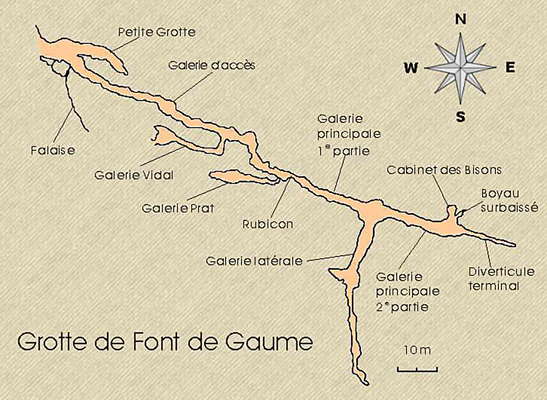
Plan de la grotte de Font-de-Gaume
Photo: (d'après l'Atlas des cavernes. Imprimerie Nationale)
http://www.culture.fr/culture/conservation/fr/grottes/Pageshtm/4-4.htm
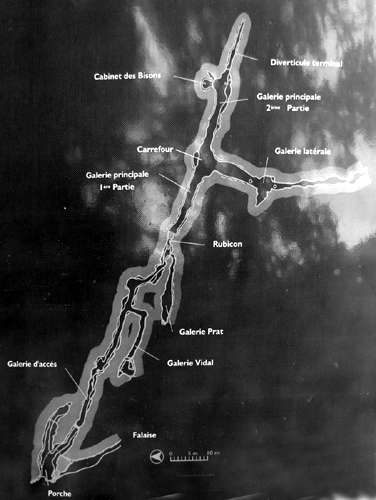
Map of the passages in the Font de Gaume
Source: A display at Font de Gaume
Photo: Don Hitchcock 2008
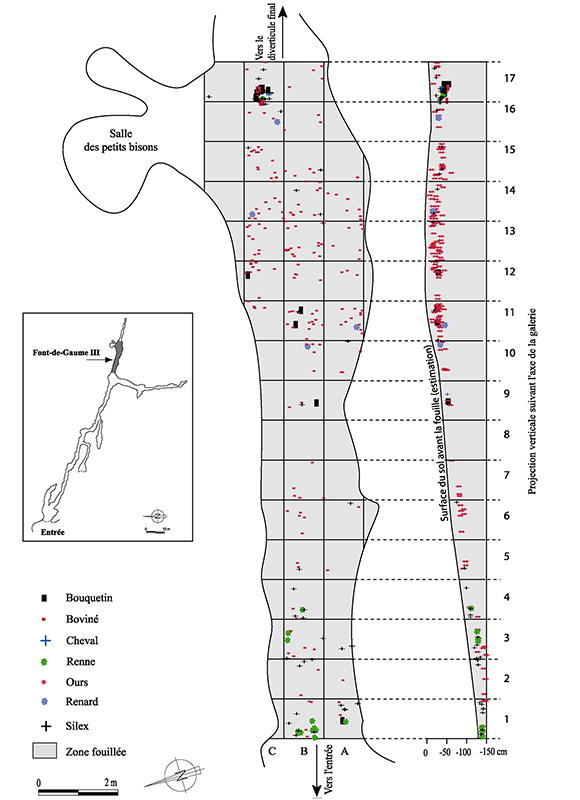
Font-de-Gaume III, excavations by F. Prat. Spatial distribution of the material according to the categories of remains.
Plan of the animals found during the excavation on the left, vertical elevation showing how far down the finds were on the right.
(note that there are large numbers of bear remains, as we would expect, and perhaps foxes would have used the cave as a den, but the surprising thing is that there are quite a number of remains of horse, bison/aurochs, ibex and reindeer. These could only have come from meals consumed by the humans who painted the cave. It looks as though they brought their picnic lunches with them when they were painting, indicating that they spent some time on the task, sufficiently so to take food with them to the walls they were painting - Don )
Bouquetin = Ibex, Boviné = Bison/Aurochs, Cheval = Horse, Renne = Reindeer, Ours = Bear, Renard = Fox, Silex = Flint.
Source: Plassard (2005)
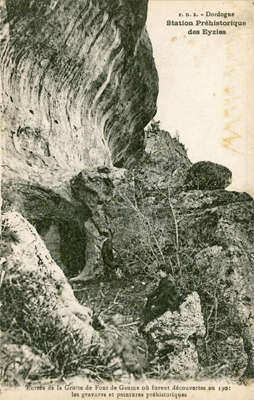
Entrance to the Font de Gaume cave, after it was discovered in 1901.
Photo: postcard, http://www.delcampe.net/
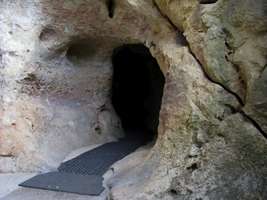
Entrance to the Font de Gaume cave, which is paved with a rubber mat so that visitors can scrape dirt off their shoes before entering, and to provide secure footing.
Photo: Don Hitchcock 2008
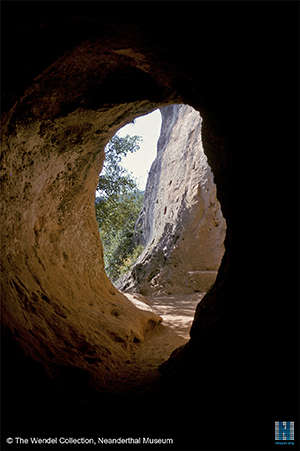
Another shot of the entrance, looking out.
Photo: Heinrich Wendel (© The Wendel Collection, Neanderthal Museum)
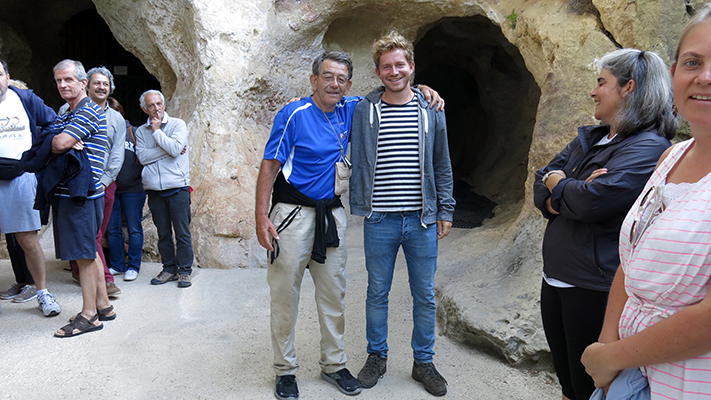
Me at the entrance to Font de Gaume with a Danish friend.
Photo: Don Hitchcock 2014
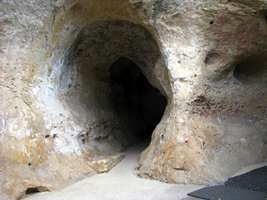
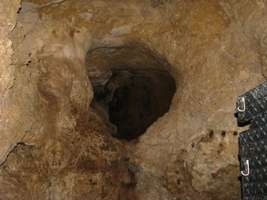
(Left) This shows a secondary entrance to a short cave of no archaeological significance, which is used to hold visitors bags while they tour the cave with a guide. The entrance to the cave proper is to the right of the baggage cave.
(Right) This is a small cave at the end of the baggage area.
Photo: Don Hitchcock 2008

View of the cliff above the cave entrance.
Photo: Don Hitchcock 2008
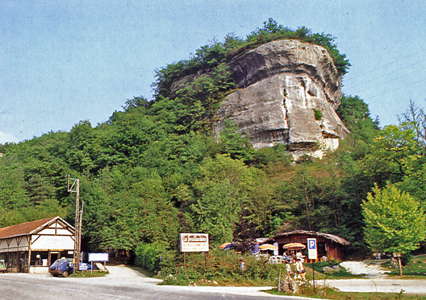
The photo shows the entrance to Font de Gaume Cave, under the cliff known also as Font de Gaume
Located near Les Eyzies, on the Sarlat road, Font-de-Gaume Cave is a showpiece of Magdalenian engravings and paintings from around 16 000 BP. The flints (chisels, scrapers, blades) and other things found in the cave during the excavations testify to a continual occupation since the Mousterian age, or the age of the Neandertals.
Discovered in 1901 by D. Peyrony, the Cave, 130 m long, contains about 250 paintings. The visitor can only see 30 of them, the most beautiful ones and the best preserved. After 60 m underground, the 'Rubicon' is the beginning of the decorated part of the cave, with red dots on the left wall. These caves were not used as dwellings, they were shrines, according to A. Leroi-Gourhan
Text and photo: Fanlac (1994)
Font de Gaume Entrance
This cave has never been closed by natural causes, as Lascaux was for example, which explains the bad state of the paintings. Though paintings are everywhere in the cave, they were not been seen (again) before 1901 (by the man who also discovered Combarelle a few weeks before). Kids of Les Eyzies used to play there and they carved their names and dates on the walls, sometimes destroying what the (supposed) Magdalenians did. Added to that, water deposited some calcite on the walls, hiding many of the paintings-carvings.
Composite image of the two cave entrances the visitor sees while waiting for the guide, and latecomers to the tour.
The entrance of Font de Gaume is on the right. On the left, it's only a small cavity - small compared to the cave itself (nowadays it is used to leave personal bags, and everything that could touch the walls by mistake during the visit). This is the natural shape, but they modified the floor to make it safe and flat.
Photo: Don Hitchcock 2008
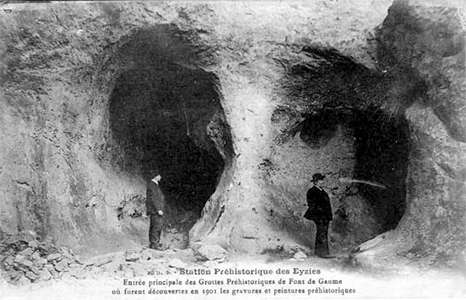
Early post card of Font de Gaume.
Photo: http://catherinearnoux.perso.neuf.fr/cpa/liscart/cpa24/24cpa/gaum.htm
Les figures peintes à l'époque paléolithique sur les parois de la grotte de Font-de-Gaume (Dordogne)
Translation: Don Hitchcock
The cave of Font-de-Gaume is 1.5 km from Les Eyzies, at the entrance of a small valley that opens into the valley of the Beune (the latter being a tributary of the Vézère). To get there, it is necessary, from the road going from Les Eyzies to Sarlat, to cross a rock scree along a grassy slope with difficult access. One arrives at the entrance, 500 metres from the road, at the base of a Cretaceous cliff which overlooks the slope formed by the rocky scree, 20 metres or so above the floor of the valley.
The entry to the left ends quickly in a cul-de-sac. It contains traces of a bear den. The right one shrinks in size quite rapidly and winds into the hill as a fairly irregular gallery crowded with large staligmitic columns.
At a point 65 meters from the entrance, one comes up against a wall of stalagmite. At about three metres in height, one can see two curious tectiforms, engraved signs of which we saw many later. They appear to be unchanged since prehistoric times. At 160 cm above the floor, there is a very narrow slit, an opening in the stalagmite wall. Here we had to slip through to enter the great hall which follows.
(This narrow passage is now known as the Rubicon - Don )
![]()
Glass Negative photograph of part of the access gallery, with a ladder at the Rubicon, a narrow crack which had been widened by this time. The floor has now been lowered so that climbing the ladder is now no longer necessary, though the cave still narrows to an entry only a metre or so wide. On the left wall at this point are two painted bison, and on both walls are marks left by the claws of the cave-bear.
The main gallery or great hall is beyond the Rubicon.
Photo: Capitan et Breuil (1910)
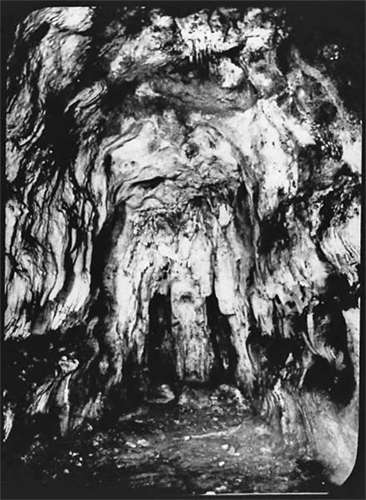
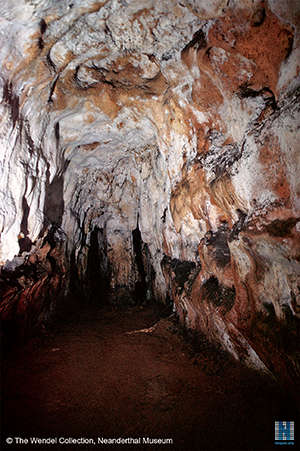
(left): Glass Negative photograph of the end of the lateral gallery with a stalagmite column.
(right): Photograph of the Galerie Latérale ca 1970s.
Photo (left): Capitan et Breuil (1910)
Photo (right): Heinrich Wendel (© The Wendel Collection, Neanderthal Museum)

Galerie Latérale.
Photo: Heinrich Wendel (© The Wendel Collection, Neanderthal Museum)
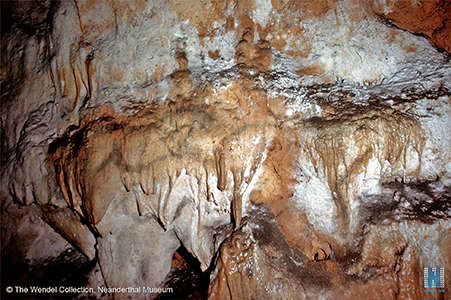
Horses covered in calcite in Galerie Latérale.
Photo: Heinrich Wendel (© The Wendel Collection, Neanderthal Museum)
The great hall is about 40 metres long with a width of 2 to 3 metres and a very variable height of 5 to 8 metres. Two galleries leave this room, one which continues to the end of the cave, 120 metres from the entrance, where it ends in the form of a crack. The other is perpendicular to the main gallery and also ends in a crack after a course of about 30 metres.
On the walls of this room we could clearly distinguish 80 figures, often covered with a calcite glaze and sometimes masked in part by the calcite. The images are as follows: 49 aurochs, 41 indeterminate animals, four reindeer, four horses, three antelope, two mammoths, 7 signs of various types.
These figures are placed at different heights on the walls, sometimes almost at ground level, sometimes about 2 metres high. The method of execution is very variable. Sometimes they are deep, clear engravings incised in stone, such as the beautiful head of an antelope which we present a tracing of here. At other times, the engraving is very fine and shallow, indicating a less steady hand than in the previous case: such as a curious little figure of a mammoth which we shall discuss later. Sometimes the figure is bounded by a sort of scraping of the rock giving an aspect of Champlevé.
(Champlevé is an enamelling technique in the decorative arts, or an object made by that process, in which troughs or cells are carved, etched, die struck, or cast into the surface of a metal object, and filled with vitreous enamel - Wikipedia )
Finally, engraved lines have been covered with paint or have otherwise been traced over.
The painting was completed using red ochre and black manganese oxide from deposits which were found in the vicinity. They were prepared before use by a kind of coarse grinding and by mixing with water, as M. Moissan established by examining samples of these pigments which we submitted to him. Sometimes the colour is applied as red or black lines circumscribing an animal, sometimes in the form of flat colours juxtaposed, sometimes both colours are mixed to give very interesting graduated shades of colour.
In the first example of painting, a red line was implemented for the silhouette of the upper part of the body of an animal whose head, very expressive in its simplicity, seems to represent a horse or a female elk (moose ) without horns. Other images using the red line silhouette are some small bison. Figures traced with a black line, simply showing the outline of the animal are numerous. Some large animals (1 metre long) painted on the walls in the middle of the main gallery (bison, deer) are well drawn.
Flat black shades were used, first for a strange animal that seems to end on each side of the rump, we could not discern the head. Another figure refers to a horse or perhaps an antelope whose trunk and legs are depicted, but the neck is extremely long. This may reflect the fact that this animal is painted at the end of the cave and is located on the wall of a crack where we can only view it very obliquely and from the rear.
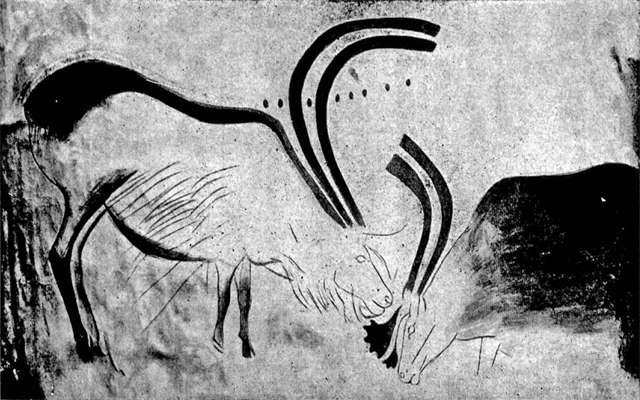
This combination of engraving, with black lines delineating the shape, and with flat black and red colours inside the bounding lines, is very evident in the remarkable group of two facing reindeer which we show here. These animals were carefully delineated by a sharp line only for the heads. In addition, the reindeer on the left has a clear scraping of the rock on the edge of the back, delimited within by a red line.
This in turn is surrounded by a broad black deteriorated band which depicts the hindquarters of the animal. The horns are black and pass through a line of eight bluish-black spots.
The upper antlers of the other reindeer are painted in red pigment, the antlers at the front are flat and fingered, so characteristic of the reindeer, and are painted in black.
The trunk is smeared with a degraded red ochre tint. The group measures 210 cm in length, and is 130cm high.
Photo and text: Capitan et Breuil 1903
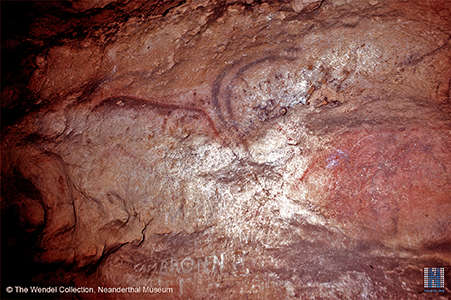
Two Reindeer, Galerie Principale.
Photo: Heinrich Wendel (© The Wendel Collection, Neanderthal Museum)
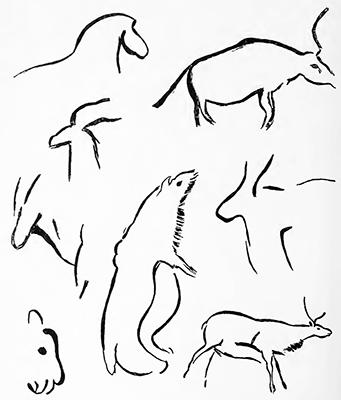
Painted outlines of animals from the cavern walls of Font-de-Gaume, attributed by Breuil to the early Aurignacian. The outlines represent the horse, ibex, cave-bear, aurochs, and reindeer.
Photo and text: Osborn (1915)
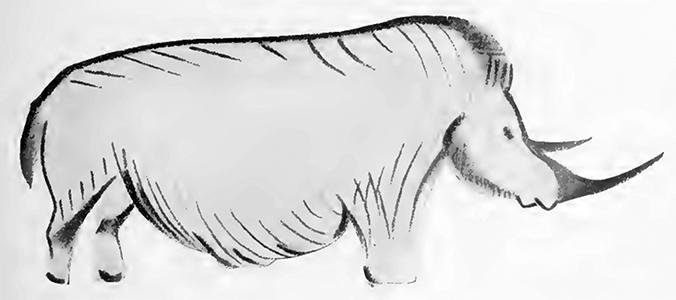
The woolly rhinoceros, painted in red ochre with shading and partial representation of the hair, in the cavern of Font-de-Gaume, Dordogne. Attributed by Breuil to the late Aurignacian. Possibly Magdalenian. After Breuil.
Photo and text: Osborn (1915)
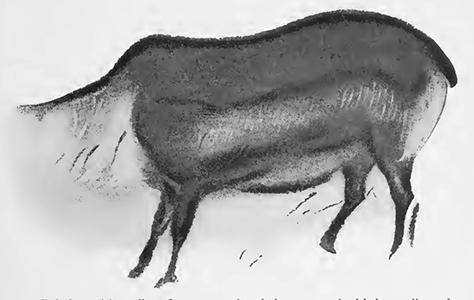
Reindeer with outlines first engraved and then retraced with heavy lines of black manganese finely finished with a wash of grey tone, from the Galerie des Fresques at Font-de-Gaume. After Breuil.
Photo and text: Osborn (1915)
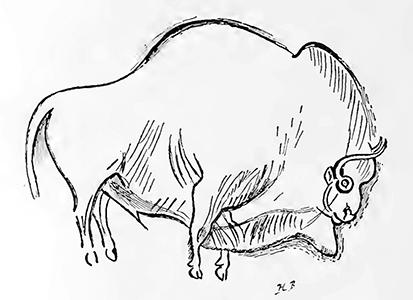
Outline of one of the bison in the Galerie des Fresques at Font-de-Gaume, showing the preliminary etching or engraving preparatory to the polychrome fresco painting. After Breuil.
Photo and text: Osborn (1915)
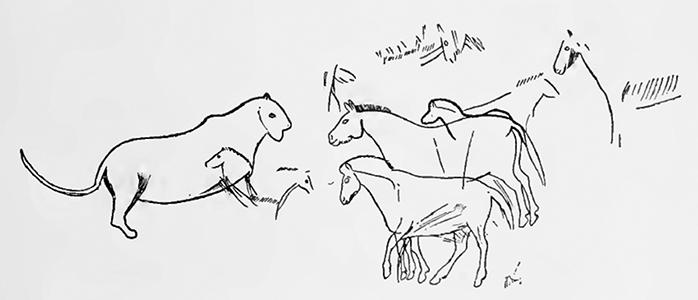
Outlines of a lion and a small group of horses, a delicate wall engraving in the Diverticule final of the cavern of Font-de-Gaume. After Breuil.
Photo and text: Osborn (1915)
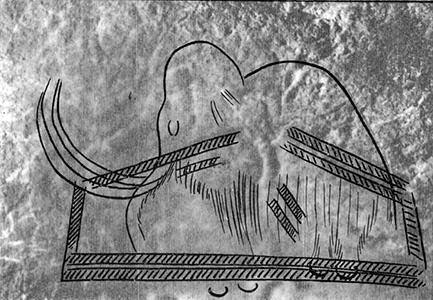
Mammoth with superimposed tectiform, Font-de-Gaume. After Breuil.
Photo: http://doglawreporter.blogspot.com.au/2013/02/canine-domestication-may-have-begun.html
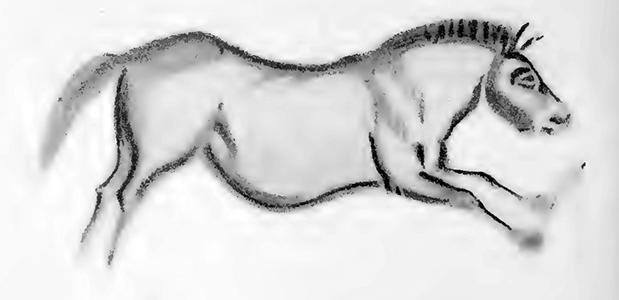
Galloping horse painted in black and white, from a wall of the cavern of Font-de-Gaume. After Breuil.
Photo and text: Osborn (1915)
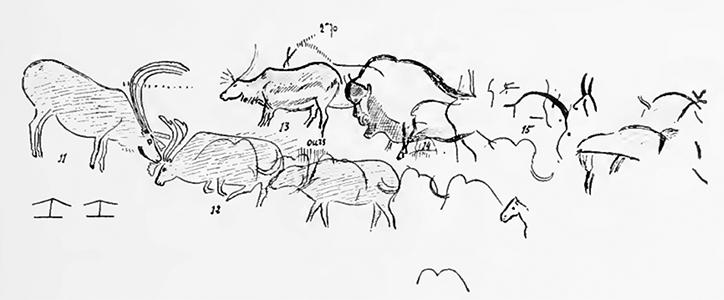
Plan of a portion of the left wall decoration in the Galerie des Fresques at Font-de-Gaume, showing reindeer and the procession of bison. After Breuil.
Photo and text: Osborn (1915)
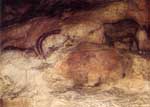
 On the left wall, just before the crossroads is the famous scene of a male reindeer licking a kneeling female reindeer, with a line of other reindeer behind. It's possible to see the black
reindeer tongue brushing the female forehead.
On the left wall, just before the crossroads is the famous scene of a male reindeer licking a kneeling female reindeer, with a line of other reindeer behind. It's possible to see the black
reindeer tongue brushing the female forehead.
Text and photo: Fanlac (1994)
My thanks to Anyasun for finding this book.
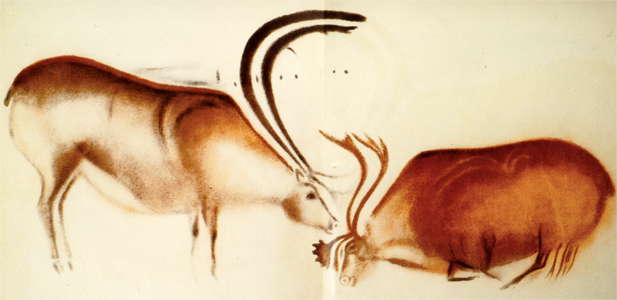
The 'Licking Reindeer' as drawn by Henri Breuil (photo Philippe Jugie).
Photo and text: Desdemaines-Hugon (2010)
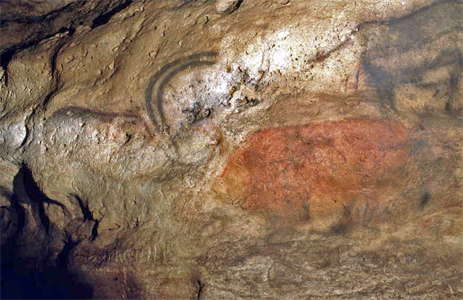
Two reindeer, among the most beautiful representations of this prehistoric animal, the left back well engraved with a black outline and a strongly coloured brown head stretched forward towards a second kneeling reindeer. The lower parts are damaged by loss of pigment. The left has its dorsal line strongly engraved, the contour is dark. It is bending to a second, red, female reindeer.
Photo and text: http://www.culture.gouv.fr/culture/conservation/fr/grottes/Pageshtm/11720.htm
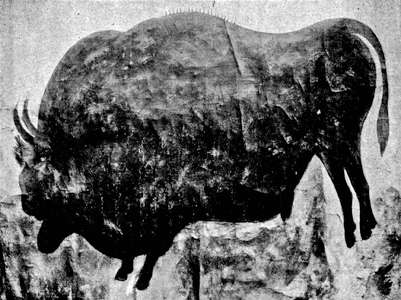
The remarkable Bison shown here is found in a kind of small diverticulum 300 cm high, and 250 cm wide and deep, found in the left wall of the large gallery. It is there in the company of 12 other bison that cover the walls and ceiling. It is very carefully drawn in a fine line, shallow but extremely skilful. The general colour is brown, which indicates a mixture of red and black ochre. On the forehead is a red tuft of hair.
There is a bit of scraping on the edge of the back. It measures 100 cm in length and is 60 cm high. The drawing is very accurate, skilful and spontaneous, and the movement of the running animal is remarkably well shown. The whole figure is covered with a glaze of calcite, through which one can see the painting.
Photo and text: Capitan et Breuil 1903

This large bison represents an animal at rest, with an exaggeration of its characters, perhaps due, in large part, to the fact that the rock at this point is very irregular and forms towards the middle of the body a very marked projection.
The animal is carefully drawn, and the legs in particular are treated with remarkable accuracy. The line of the back and the outline of the horns shows a distinct scraping. The contour of the back is indicated by a broad black line. Finally, the body is painted with red ochre skilfully nuanced with brown. The top of the head is red, the muzzle is brown, and the horns are black. It measures 150 cm long and 125 cm high.
Photo and text: Capitan et Breuil 1903
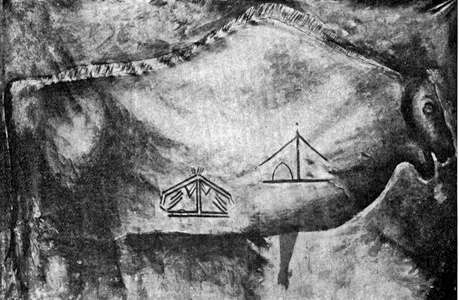
Finally, the largest figure is that of the bovid shown here. A large rock surface with projections which reproduce roughly the body shape of an ox was marked out on the upper part by a strong scraping and completely smeared with well nuanced red ochre pigment. The anterior part of the body of the animal is darker, and the head is poorly drawn.
The figure measures 270cm long by 130 cm high. On the body can be seen two large tectiform signs painted in almost pure red ochre and very much like drawings of huts or tents.
Photo and text: Capitan et Breuil 1903
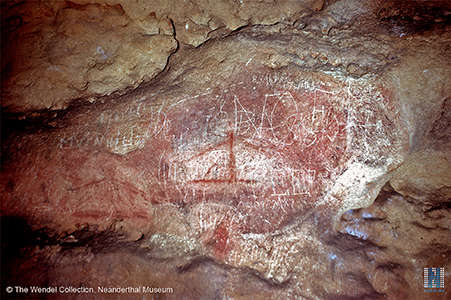
Tectiformes on a bison, Galerie Principale.
Photo: Heinrich Wendel (© The Wendel Collection, Neanderthal Museum)

Tectiforms, Font de Gaume, painted over the top of a bison.
Photo: http://www.culture.gouv.fr/culture/conservation/fr/grottes/Pageshtm/11715.htm

Under the sign to the left on the bovid shown above, covered with paint, you can see a very curious finely drawn little mammoth, showing all the characters of the species: the shape of the forehead, the curved tusks, the long hair. It measures 30 cm long by 23 cm high.
Photo and text: Capitan et Breuil 1903
Amongst other figures that can be seen on the walls of the large gallery, there is a range of bison in red or in black, it is the animal most often depicted, as well as antelope, reindeer of which only the heads are visible through the calcite, and finally a series of these curious tectiform signs, usually in pairs, either just engraved or just painted. We were able to identify two series, with some variations.
Five tectiforms, engraved, are similar to those that are painted on the belly of the great bovid, and there are only a few dissimilarities in the characteristics exhibited by the triangular figures, which all retain the same general form. Two others, painted in red ochre, dotted, are a little different. They look like a ladder incurved slightly towards the middle and seem to have some analogy with scalariform (ladder like) signs reported by Piette on burned bones and even on coloured pebbles.
These are the most striking figures we have identified to date, but we will draw, in the next campaign, all the visible figures on the walls of the cave.
We will refrain from further comment, but we would like to point out that these caves are in complete darkness. It was necessary that prehistoric man could light the cave. They were able to achieve this using torches or lamps, similar to those discovered by M. Riviere in the cave of La Mouthe, and they are composed of a pebble hollowed out, in which a wick of moss is lit in fat, as current Eskimos do today with similar lamps. If we do not find traces of prehistoric smoke that came from these various lighting methods, the reason is that, as noted by Mr. Moissan, the illustrious chemist, organic carbon and similar products are oxidised by air and disappear fairly quickly. In other places, runoff of moisture was sufficient to produce the same effect.
These strange figures raise many other issues. Why have they been implemented? In this context we simply say that it could be that there was a religious or fetishistic practice, these animals could be considered the equivalent of totems of current primitive tribes.
M. Salomon Reinach, noting that the animals represented are useful animals for humans and are generally fat and plump, told the meeting that they might be representations designed to help in magically multiplying these animals. In this regard, he recalled the ceremonies of Australian Aboriginals to promote the proliferation of kangaroos that they hunt, and during which ceremonies, covered with the skins of these animals, they imitate them in special dances, and draw magic figures on the ground.
Concerning their age, all these figures, although Palaeolithic in all likelihood, are perhaps not all exactly the same age. The beautifully nuanced paintings could well be from the end of the Magdalenian period, thus a little less ancient than the engravings of les Combarelles.
In any case, we wanted to save these precious figures from destruction. At our request, Mme Esclafer, owner of the land which one must cross to get to the cave, and M. Dellmarès, owner of the cave, kindly donated their property to the state. We can not thank them enough, on behalf of all scientists.
It is indeed a remarkable example of prehistoric painting, the only complete examples, and the first clearly demonstrated. The paintings of Altamira were at first denied recognition of their authenticity, which is not the case at Font de Gaume. For this reason we have come to the Academy, to discuss the paintings and to display copies of the figures.
Painting by Breuil. Style IV, ca 14 000 BP.
What is so special with Font de Gaume is that the animals are carved, then painted inside the carving. It's a great thing, because if the paint disappears, most of the carving can still be seen. Recently, about 3 years ago, they renovated the ground of the cave for tourists. Before doing that, they studied the walls again, to be sure they did not miss any paintings.
They discovered something like 180 new 'things', from animals to simple signs. Most of them are behind a layer of calcite, and can be seen only with a UV or IR light. Utika says 'the guide showed the visitors a really cute little mammoth, about the size of my hand that they missed before. It was also then that they discovered the wolf. Only the carved part of that wolf survived'
Photo: Capitan et Breuil 1910
Text: Utika 2002
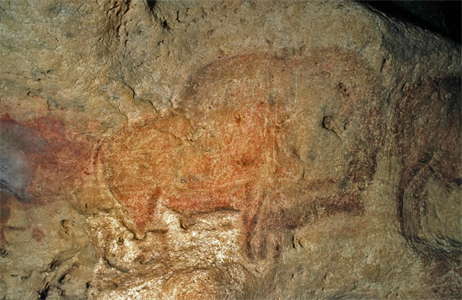
Polychrome bison, forming part of a frieze. The natural contours of the rock were used to implement this figure, which includes a very marked outline in red-brown highlighted with a line etched directly onto the exposed substrate. The body of the animal now seems much lighter than it would have been originally. For this part of the cave and in particular this representation there is no trace of concretions covering the pigments. It may be that the pigments have eroded from the surface.
Photo and text: http://www.culture.gouv.fr/culture/conservation/fr/grottes/Pageshtm/FtGaumeBisonNu.htm
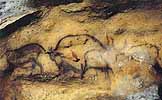 Bison et cervidé de la Frise noire.
Bison et cervidé de la Frise noire.
Bison and deer on the black panel.
Photo from: Agenda de la Préhistoire 2002 - 2003, a superb diary with excellent illustrations sent to me by Anya. My thanks as always.
 Ensemble des peintures du carrefour
Ensemble des peintures du carrefour
Another view of the Bison and deer on the black panel at the crossroads.
Photo from: a Castelet postcard sent to me by Anya. My thanks as always.
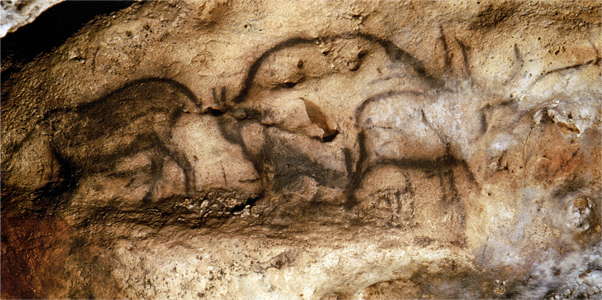
The black frieze: a bison and a deer in the centre are superimposed and facing in opposite directions for a three dimensional effect. Another deer is to the left, drawn in bold and masterly lines, and part of a bison can be seen at right. The central deer has the face in profile, but the horns are almost face on.
Photo and text: Desdemaines-Hugon (2010)
Photo © N. Aujoulat-CNP-MCC.

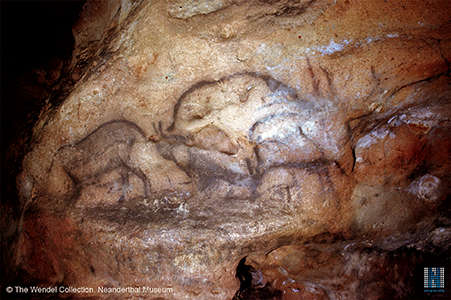
Bison and deer.
Photo: Heinrich Wendel (© The Wendel Collection, Neanderthal Museum)
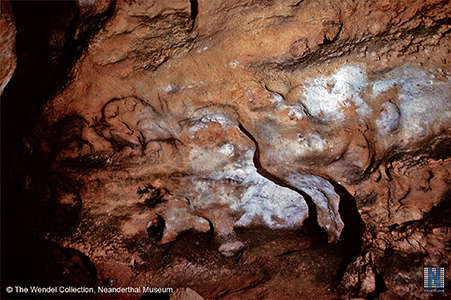
Bison and deer.
Photo: Heinrich Wendel (© The Wendel Collection, Neanderthal Museum)
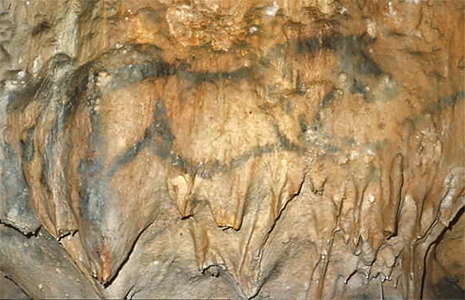
Black horse drawn using the natural forms of the rock.
The artist has incorporated natural forms of the rock relief in the work. This horse is one of the best examples that can be given in Palaeolithic art, the use of pre-existing forms. The hind limb and tail are suggested by a concretion, the curve of the belly by calcite drapery. The prehistoric artist highlighted the contours suggested by the natural relief by thick black lines. Concretions developed after the painting was completed which covered the prehistoric painting with a thin layer of calcite ensuring its protection.
Photo and text: http://www.culture.gouv.fr/culture/conservation/fr/grottes/Pageshtm/chevaux.htm
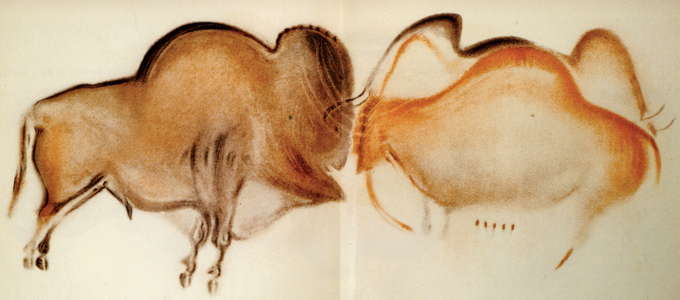
Two bison head to head, with superposed mammoth(s), as drawn by Henri Breuil (photo Philippe Jugie).
Photo and text: Desdemaines-Hugon (2010)

Superimposed bison, mammoths, reindeer and horses as drawn by Henri Breuil (photo Philippe Jugie).
Photo and text: Desdemaines-Hugon (2010)
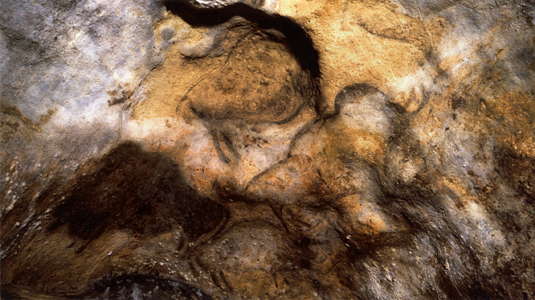
The 'Small Bison Chamber', or 'Cabinet des Bisons'. Four bison form a circle in the centre of the rotunda. The animal to the right is half bison (the rear) and half mammoth (the tusks). The left hand black bison's tail flows elegantly down to form that of the lower bison. This alcove contains many other animals and signs.
Photo and text: Desdemaines-Hugon (2010)
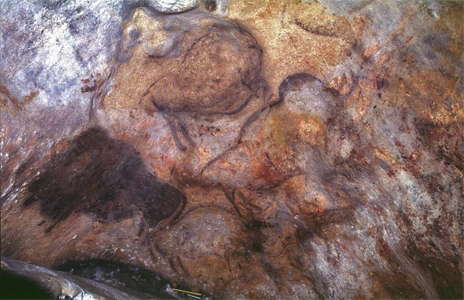
Another version of the photo above.
The domed roof of the diverticulum of the main gallery is decorated with polychrome bison partially covered with white calcite deposits more or less thick and translucent. This area is particularly sensitive to the presence of visitors.
Photo and text: http://www.culture.gouv.fr/culture/conservation/fr/grottes/Pageshtm/FtGaumeCabinetBisons.htm
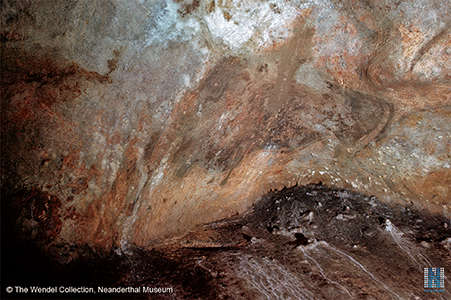
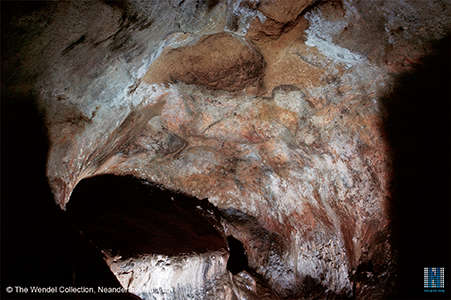
In the Bisons Chamber.
Photo: Heinrich Wendel (© The Wendel Collection, Neanderthal Museum)
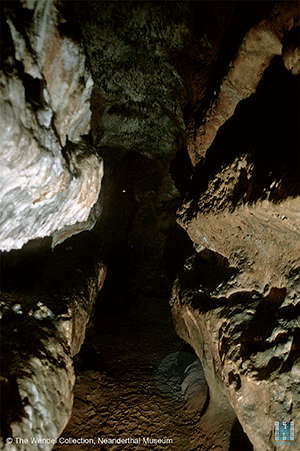
Diverticule Terminale.
Photo: Heinrich Wendel (© The Wendel Collection, Neanderthal Museum)
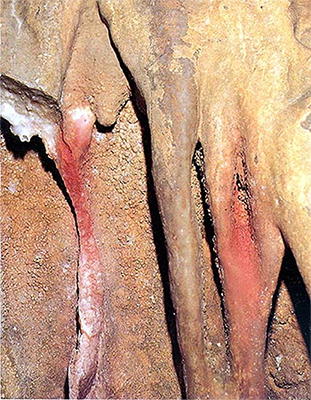
Vulva created using red ochre and the natural concretions of the wall.
Photo: Vialou (1991)
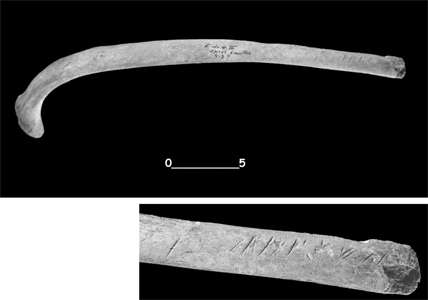
Cave bear bones from Font de Gaume - cutmarks on the outer side, near the ventral extremity, of an Ursus spelaeus.
Two main archaeological levels have been recognised at Font de Gaume and have been described by Prat et al. (1969):
Layer 3 is very rich in fauna and the Reindeer is the best represented taxon. The industry is quite extensive and has been attributed to a typical Aurignacian;
Photo: © P. Jugie, MNP, Les Eyzies
Text: Armand et al. (2003)
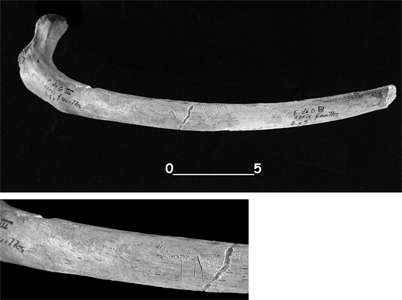
Cave bear bones from Font de Gaume - Cutmarks on the external side, in the middle part of an Ursus spelaeus.
below layer 3, in layers 4-5, the Bear is the dominant animal (followed by Ibex, Horse, Bovinae, Wolf and Deer) and according to the dimensions of the long bones, Ursus spelaeus.
Human remains (a tooth, to which is added a phalanx, or finger bone, which had not been described previously) and some lithic remains, including two Châtelperron points are also present in this level.
Photo: © P. Jugie, MNP, Les Eyzies
Text: Armand et al. (2003)
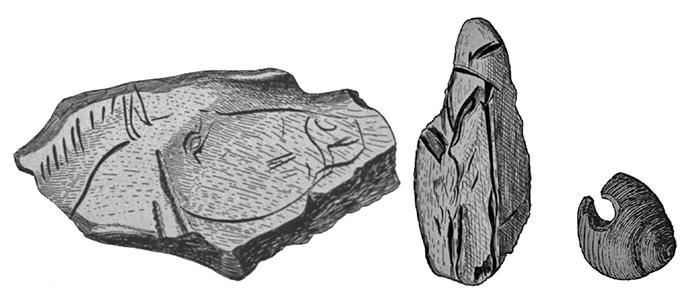
Font-de-Gaume, Galerie principale.
From left to right, head of horse engraved on a fragment of bone, length 85 mm, drawing by H. Breuil.
Fragment of bone marked with deep incisions, length 80 mm, pierced shell, diameter 15 mm, after Capitan et al. (1910)
Photo: Capitan et al. (1910)
Source: Plassard (2005)
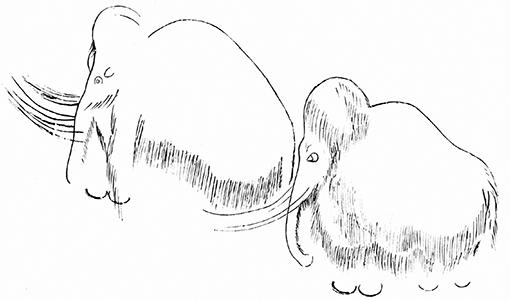
Font-de-Gaume, Galerie principale, left wall. Mammoths engraved at the foot of the Rubicon.
Length of the panel 120 cm.
Photo: Capitan et al. (1910)
Source: Plassard (2005)

Font-de-Gaume, Galerie principale, left wall. Reindeer facing each other. Drawing of the engraved part.
Length of the panel 250 cm.
Montage F. Plassard, after Capitan et al. (1910)
Photo: Capitan et al. (1910)
Source: Plassard (2005)
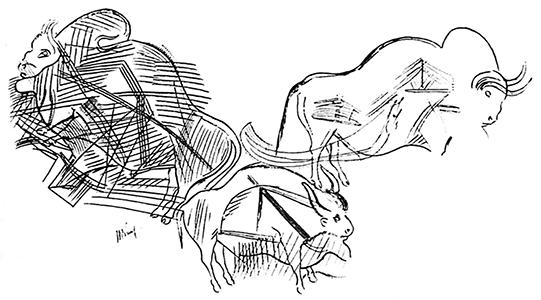
Font-de-Gaume, Salle des petits bisons. Drawing of the engraved part of bisons 24, 25, 26 and associated signs, by H. Breuil.
Length of the panel 200 cm.
Photo: Capitan et al. (1910)
Source: Plassard (2005)
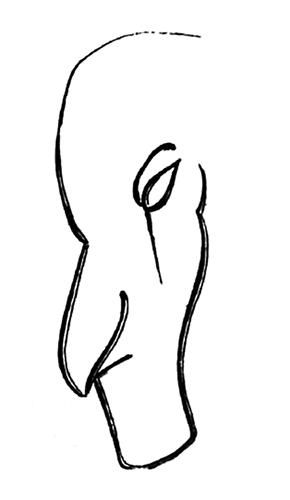
Font-de-Gaume, Salle des petits bisons. Profile of an engraved human face, by H. Breuil.
Height 23 cm.
Photo: Capitan et al. (1910)
Source: Plassard (2005)

Font-de-Gaume, Galerie principale, left wall. Bison No. 9 with superimposed tectiforms, watercolour by Breuil.
Length of panel 225 cm.
Photo: Capitan et al. (1910)
Source: Plassard (2005)

Font-de-Gaume, reindeer, watercolour by Breuil.
Photo: Abbé Henri Breuil, 1910
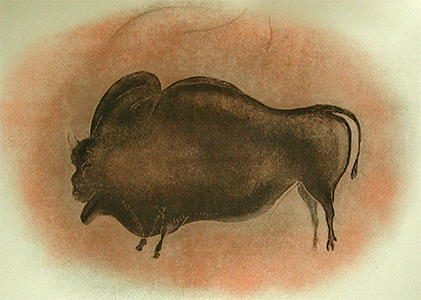
Font-de-Gaume, Salle des petits bisons, left wall. Bison No. 24, watercolour by Breuil.
Length of panel 100 cm.
Photo: Capitan et al. (1910)
Source: Plassard (2005)
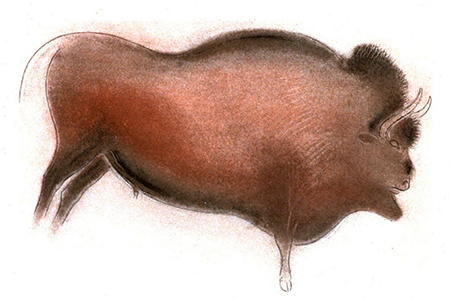
Font-de-Gaume, Bison No. 19 on the left wall of the Galerie principale. Length 105 cm.
Photo: Abbé Henri Breuil, 1910, Capitan et al. (1910)

Font-de-Gaume, Diverticule final. Rhinoceros, watercolour by Breuil.
Length 65 cm.
Photo: Capitan et al. (1910)
Source: Plassard (2005)
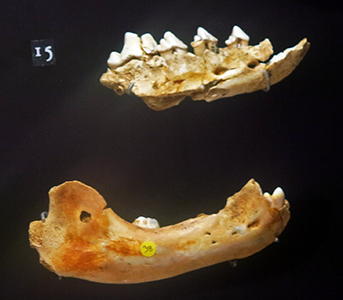
From Font de Gaume:
(above) Mandible of a wolf
(below) Mandible of a bear cub
Photo: Don Hitchcock 2014
Source: Originals, le Musée National de Préhistoire, Les Eyzies-de-Tayac
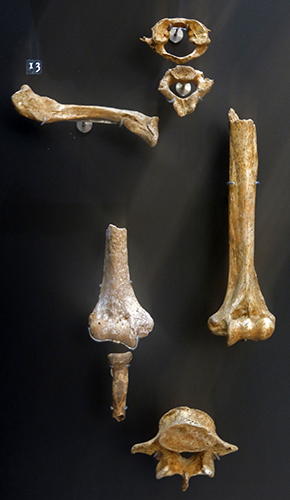
Bronze Age human bones from Font de Gaume.
Photo: Don Hitchcock 2014
Source: Originals, le Musée National de Préhistoire, Les Eyzies-de-Tayac
The Font de Gaume 'River'
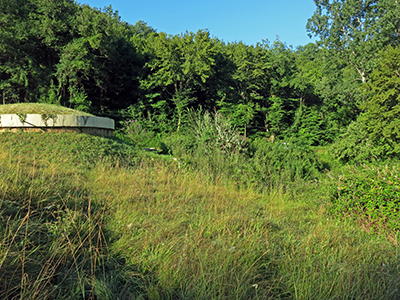
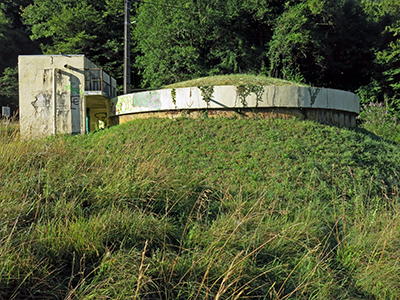
The spring, or fountain, from which Font de Gaume is named is five hundred metres up the small valley in which Font de Gaume is situated. The spring itself is now capped, presumably to protect it from livestock, by a massive concrete structure with a concrete block house beside it.
Photo: Don Hitchcock 2014
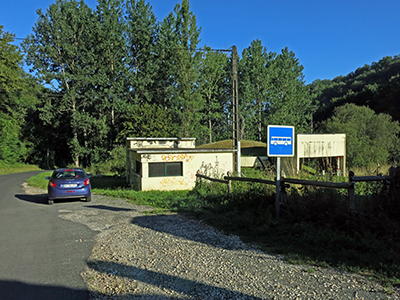
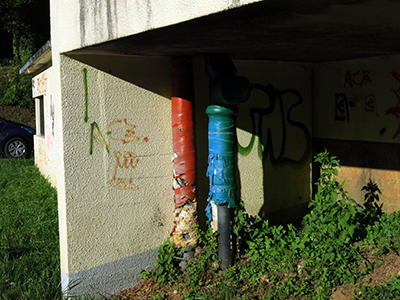
The road goes down the true left bank of the river, with the spring close by the road on the South Western side. The whole structure seems greatly over engineered if all that was required was to protect the spring from livestock. The water may be heard going through the pipes pictured here.
Photo: Don Hitchcock 2014

The spring continues to flow, and can be heard tinkling over a drop into a massive bank of blackberries and undergrowth.
Photo: Don Hitchcock 2014
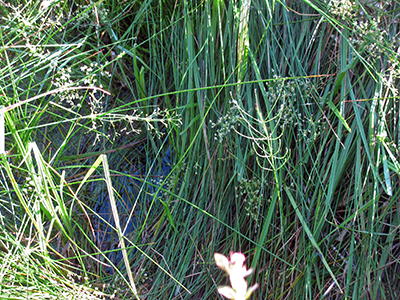
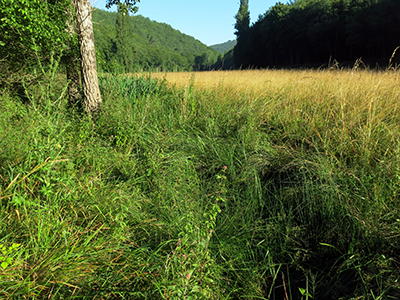
The 'river' eventually reappears further down the valley, but it is never more than a metre or two wide, and half a metre deep. Usually the only indication of the stream is a profusion of lush growth of reeds and rushes.
Photo: Don Hitchcock 2014
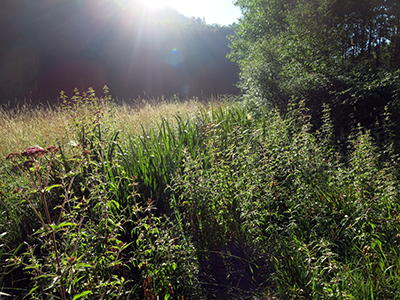

It disappears before getting to the ticket office of Font de Gaume, but presumably flows underground to meet the Beune River a hundred metres away.
Photo: Don Hitchcock 2014
References
- Armand D., Plassard F., Prat F., 2003: L’ours des cavernes de Font-de-Gaume III Paléo, 15 | 2003 pp. 241-244
- Capitan L., Breuil H., 1903: Les figures peintes à l'époque paléolithique sur les parois de la grotte de Font-de-Gaume (Dordogne), Comptes-rendus des séances de l'Académie des Inscriptions et Belles-Lettres, 47e année, N. 2, 1903. pp. 117-129.
- Capitan L., Breuil H., Peyrony D., 1910: La caverne de Font-de-Gaume aux Eyzies (Dordogne), Imprimerie Veuve A. Chêne, Monaco. 271 p., 244 fig., 65 Pl..
- Desdemaines-Hugon C. , 2010: Stepping Stones, Yale
- Fanlac P. , 1994: La Grotte de Font-de-Gaume, Editions Fanlac
- Leroi-Gourhan A., 1984: L'Art des cavernes : Atlas des grottes ornées paléolithiques françaises, Relié – 1 décembre 1984
- Osborn H. , 1915: Men of the Old Stone Age, New York, Charles Scribner's Sons
- Peyrony, 1922, Les Eyzies et les Environs, Ussel, Eyboulet et fils
- Plassard F., 2005, Les grottes ornées de Combarelles, Font-de-Gaume, Bernifal, et Rouffignac. Contexte archéologique, thèmes et style des représentations.Archaeology and Prehistory, Université Sciences et Technologies - Bordeaux I, 2005.
- Prat F., Sonneville-Bordes D., 1969: Découvertes récentes de paléolithique supérieur à la grotte de Font-de-Gaume (Dordogne) Quaternaria, XI, Roma, pp. 115-132
- Vialou D., 1991: La prehistoire (L'univers des formes), Gallimard (1991)
